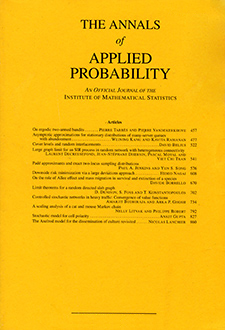Abstract
De Gunst has formulated a stochastic model for the growth of a certain type of plant cell population that initially consists of $n$ cells. The total cell number $N_n(t)$ as predicted by the model is a non-Markovian counting process. The relative growth of the population, $n^{-1}(N_n(t) - n)$, converges almost surely uniformly to a nonrandom function $X$. In the present paper we investigate the behavior of the limit process $X(t)$ as $t$ tends to infinity and determine the order of magnitude of the duration of the process $N_n(t)$. There are two possible causes for the process $N_n$ to stop growing, and correspondingly, the limit process $X(t)$ has a derivative $X'(t)$ that is the product of two factors, one or both of which may tend to zero as $t$ tends to infinity. It turns out that there is a remarkable discontinuity in the tail behavior of the processes. We find that if only one factor of $X'(t)$ tends to zero, then the rate at which the limit process reaches its final limit is much faster and the order of magnitude of the duration of the process $N_n$ is much smaller than when both occur approximately at the same time.
Citation
Mathisca C. M. de Gunst. Willem R. van Zwet. "A Non-Markovian Model for Cell Population Growth: Tail Behavior and Duration of the Growth Process." Ann. Appl. Probab. 3 (4) 1112 - 1144, November, 1993. https://doi.org/10.1214/aoap/1177005275
Information





